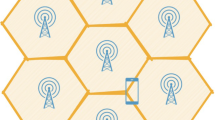Abstract
The work on GSM, a standardized European second-generation cellular system, was started in 1982 in order to prevent the fragmentation of the first-generation cellular market from continuing into the second generation. The goal was to define a system with open interfaces for Pan-European use that would offer the best compromise between a number of conflicting requirements, such as spectrum economy, high speech quality, low cost, and a large range of services. A broad outline of the novel features is presented, both concerning the architecture of the system and of the services offered, as well as the reasoning behind the more important choices. Finally, some views are presented concerning the future development of GSM and of the third-generation system, the co-called Future Public Land Mobile Telecommunication System, commonly referred to as FPLMTS.
Similar content being viewed by others
References
P.A. Ramsdale, Personal communications in the UK—Implementation of PCN using DCS 1800,International Journal of Wireless Information Networks, Vol. 1, No. 1, pp. 29–36, 1994.
Bibliography
M. B. Pautet and M. Mouly,The GSM System for Mobile Communications, Paris, 1992 (ISBN 2-9507190-0-7).
A. Maloberti, Definition of the radio subsystem for the GSM pan-European digital mobile communication system,Proc. ICDMC, Venice, 1987.
A. Maloberti, Radio transmission interface of the digital pan-European mobile system,Proc. IEEE Vehicular Technology Conference, San Francisco, 1989.
B. Mallinder, An overview of the GSM system,Proc. DCRC, Hagen, Germany, 1988.
GSM Technical Specifications, ETSI, Sophia Antipolis, 1992.
Author information
Authors and Affiliations
Rights and permissions
About this article
Cite this article
Haug, T. Overview of GSM: Philosophy and results. Int J Wireless Inf Networks 1, 7–16 (1994). https://doi.org/10.1007/BF02117288
Issue Date:
DOI: https://doi.org/10.1007/BF02117288




